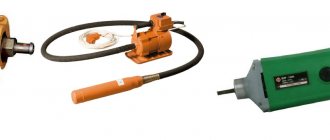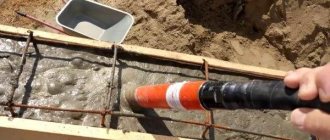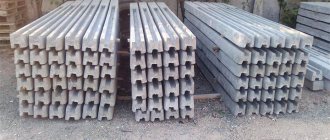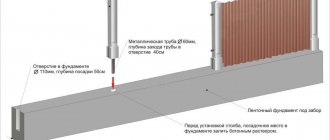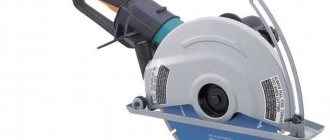The need to make a construction vibrator for concrete with your own hands may be needed in a variety of situations. A vibrator is a specialized construction equipment that is used to improve the properties of poured concrete structures. Thanks to a vibrator, air bubbles can be removed from a freshly poured solution, distributing the moisture evenly and achieving a homogeneous structure and the strength of the monolith.
Today the market offers a large selection of vibrators, but their prices are quite high. Therefore, in the case of one-time work or simply no desire to spend money on a device, you can design an internal vibrator for concrete with your own hands.
Typically, equipment is made on the basis of a rotary hammer or drill, adding certain structural components and modifying some mechanisms.
Vibrator design: options for main components
There are different vibrators for concrete. Depending on the method of interaction with concrete, the device can be submersible (deep) or surface. You can make both types of devices yourself. Regardless of what the operating principle of a concrete vibrator is, the design includes the following basic elements: a drive as the main mechanism of the entire system (which activates other parts), a shaft and an unbalance that creates vibration.
The drive is usually hydraulic, electric, fuel or pneumatic motors. To assemble a homemade vibrator at home, you usually choose electric motors from rotary hammers, drills, lawn mowers, grinders, or other tools.
Basic requirements for the engine: minimum speed of 3000 rpm or more, the ability to connect the device to a stationary electrical network with 220 V. The more powerful the engine, the more efficient the work will be and the less likely it is to overload.
A special vibration attachment is used as a vibration device.
, which consists of a steel impact part, a sleeve, and a rubber coupling. It will be difficult to make one at home yourself, so they usually do without this part.
Deep vibrators are equipped with a flexible shaft that transmits the drive movement to the tip. A vibrating nozzle is lowered into the thickness of the concrete monolith and spreads vibrations throughout the solution. Typically, a flexible shaft is made of steel tubes, bearings, and stainless steel rods.
If work with concrete is not carried out on an industrial scale, the simplest option is a homemade vibrator for concrete from a drill/perforator.
For what purposes is it used?
Deep devices are used for the construction, casting or assembly of monumental structures made of concrete (simple and reinforced). The vibrator is also designed to break up lumps of cement in poorly prepared mortar.
The electric apparatus is used for pouring floor slabs, columns and the following types of foundation:
- pile;
- slab;
- tape;
- screw;
- shallow;
- columnar.
The effectiveness of working out the solution with a vibration device is clearly demonstrated when coarse crushed stone is used in the work. In such an environment, air is stably retained, and it is only possible to expel it using a hardware method.
Making a vibrator from a drill with your own hands
To make the device yourself, you need to find an old drill or hammer drill at home, and then turn its main rotational movement into an oscillatory one. It is worth stocking up on the necessary materials, tools and knowledge in advance.
Selecting material for vibrator assembly
To make a vibrator for concrete with your own hands from a hammer drill, it is enough to find a tool with a power of at least 1 kW. You will need a durable stainless steel tip and eccentric attachments, as well as a few other parts.
What you need to assemble the vibrator:
- Metal rod with a cross section of 15 millimeters
- Stainless steel tube with a cross-section of 40 millimeters and a length of 55 centimeters
- Bushing and two quality bearings
- A rectangular piece of metal rod
- Flexible reinforced hose made with a layer of waterproofing (or a durable rubber tube)
- Internal rod for the tube - a cable from a speedometer is quite suitable
Tools and materials
To make a vibrator for concrete yourself, you will need the following tool: a hacksaw, electric or gas welding, metal drills, a rectangular rod.
Assembly sequence
The entire structure is assembled in a certain order. First you need to find a stainless steel tube with a diameter of 3-4 centimeters and a length of up to 60 centimeters. To make the internal rod, take a metal rod with a cross-section of 12-15 millimeters, which will move the entire system to the side and create vibrations.
After the metal tube and the central part are prepared, they need to be combined: a hole is drilled at one end of the rod, thanks to which the drive will be attached to the device. In order for the core to move without friction, several good bearings are taken, and the round part of the end of the rod is placed in the middle of them. Then it is threaded inside the tube, and the bearings are driven in until they stop on both sides.
If the end of the rod on the side of the bow protrudes strongly forward, it is cut to 5-10 millimeters. And the bearings are protected on both sides with a homemade metal cover to prevent dirt and dust from getting inside. The bearings will bear a serious load, so they must be of the highest quality.
A sleeve is attached to the second end of the flexible rod, which is designed to tightly close the rotational element of the device.
Manufacturing stages
Before you make a concrete vibrator with your own hands from a drill, you need to carefully study each of the stages of the process. Making a vibrating attachment for a drill is not that difficult.
Sequencing:
- Using a grinder to cut a steel rod of round diameter into two equal parts.
- Welding the segments to a rectangular rod on both sides.
- Installing bearings on the unbalance on both sides.
- Placing the structure in a steel tube.
- Trimming a round rod on one side exactly flush with the pipe.
- Cutting out a cover for the working end of the tip from a sheet of metal, welding it.
- Drilling at the end that comes out of the tip, two holes for joining with the shaft: one should be along the axis of rotation, exactly in the center, with a diameter and depth of 1.5 centimeters, the second should be made perpendicular to the first with a diameter of 4 millimeters and 7 millimeters from the edge.
- The smaller hole needs to be threaded for the clamping screw.
- The cable (rod) is placed in a rubber pipe, pre-lubricated, leaving a margin of up to 5 centimeters on the sides.
- Connection of vibrating tip and shaft.
- Place the hose on the vibrating head and secure it with a clamp.
- Trimming the second end of the shaft to the required length, securing it in the drill chuck so that only the cable can rotate and the hose remains stationary.
- Protection of the vibration tip with a plastic casing.
- Connecting the electric drill to the network, checking the functionality of the vibrator.
Step by step work
Manual machines for compacting concrete mixture: a - vibrator with a flexible shaft; b - vibrating mace; c — packet vibrator; g - surface vibrator; d - vibrator rearrangement diagram.
Take a stainless steel tube, it will act as a nozzle. Stainless steel is practically the only metal that is suitable in this case, since concrete is an aggressive environment, so it is worth choosing this material. Order a steel rod from a turner; it is to this rod that you will later attach the rotational movement of the drill. Weld a piece of a second, rectangular rod to this rod; its task will be to create vibration.
During rotation, this piece will create resistance and try to move the entire structure in the opposite direction, which will naturally create vibration. A hole must be drilled at one end of the rod; it must be through, and the drive will be attached to it. Take two bearings and use them to secure the prepared part inside the tube so that it can rotate freely, but there is no doubt about the strength of the fastening.
Deep vibrator: description, scope of application, device
Before making a concrete vibrator yourself, you need to understand the design features, purpose, and rules for using the tool.
Device Description
A vibrator is needed to work through the concrete solution after pouring in order to remove air bubbles from the thickness of the monolith, which negatively affect the strength and durability of the finished structure. During the pouring process, it is very difficult to avoid the appearance of air cavities in the thickness, but before the concrete hardens, it is imperative to get rid of them. And you can do this with a self-made device.
Thanks to high-frequency vibrations, excess air is released from the mixture, the concrete becomes more uniform, filling the form or formwork completely, without voids. Even low-quality concrete acquires positive characteristics of fluidity and density during vibration.
By design, vibrators are:
- External brick presses
– installed vertically on the formwork of reinforced concrete structures.
- Vibration presses
– used to create interior ceilings and floors.
- Deep
– used in private construction by immersion into the thickness of newly poured concrete.
Usually craftsmen make a submersible vibrator for concrete with their own hands, since making presses is impractical.
Scope of application of the deep vibrator
The tool is used in a variety of areas of repair and construction work - in the process of erection, casting of various concrete and reinforced concrete structures. It is relevant when pouring columnar, strip, screw, pile, slab, shallow foundation types, when constructing floors, monolithic columns, etc.
Device design
Any concrete vibrator (made with your own hands or purchased) consists of three main parts: a drive (thanks to which the vibration device works), a flexible shaft with a rubber gasket and a tip that acts as a vibrating mace.
The principle of operation of the device is simple: the vibrating attachment provokes vibrations in the concrete, the mass spreads evenly over the formwork or mold, air bubbles and voids with water come out, which significantly increases the strength and other characteristics of concrete.
Main characteristics of the vibrator:
- The motor power must be at least 1 kW.
- The depth of the shaft is 1-7 meters.
- All protective rubber elements must be present.
- The vibrating part of the tool can be narrowed downward or cylindrical, which depends on the thickness of the solution.
- The number of nozzles may vary.
- The shaft must be protected with a waterproof film made of a special polymer material.
- Number of revolutions per minute – 10000-20000.
Purpose
The prepared concrete solution, despite thorough mixing, remains heterogeneous, which leads to a violation of technical and operational characteristics. In addition to cement laitance, crushed stone and sand, it contains water and air bubbles.
If concrete is simply poured into the formwork, the result will be a structure that is heterogeneous in structure. Air will remain in the middle, shells will form, and the fillers will not “pack” into a dense monolith.
The use of a vibration compactor for concrete increases the fluidity of the mixture without additional additives, due to the movement of its components. Air inclusions are pushed onto the surface of the monolith, and the fillers are evenly distributed throughout its volume.
During operation of the vibrator, the volume of concrete poured into the formwork is reduced by 30%. This effect occurs due to getting rid of air-filled voids and more dense packing of sand and crushed stone. As a result, the strength of a massive structure reaches the maximum possible value and high density for a given grade of concrete.
Making a vibrator from a hammer drill
This option is the simplest - in this case, the air is expelled during the process of pinning the poured concrete with a round washer with a cross-section of 5-7 centimeters, screwed to the hammer drill. To create the tool you will need: a hammer drill with a power of 1.5 or more, a piece of metal reinforcement with a cross-section and length sufficient to immerse the nozzle in the solution.
On one side, a piece of reinforcement is adjusted to the shape of the shank, and on the other, it is attached to a plate or ring. You can turn on the tool only after securely fixing the parts and checking the components. The required effect is achieved through the appearance of a high-frequency reciprocating motion. A hammer drill, switched on in shock mode, efficiently breaks through layers of concrete of any thickness and density.
The assembled vibrator can be used to remove air from vertical structures (the nozzle with the plate is lowered into concrete, distributing vibrations inside the formwork barriers) and horizontal ties (simply a larger ring is placed flat).
Typically, one area is treated for about 2 minutes, then the vibrator is transferred to the next areas. If necessary, the device can be used as an external vibrator, for which its working part must be attached to the formwork.
Creating a vibrator for concrete with your own hands is a simple and doable task. Provided you follow the process technology and select high-quality materials, making a powerful and effective construction vibrator yourself will not be difficult.
Advantages and disadvantages of devices
The devices used for domestic and industrial purposes have the following advantages over other methods of concrete compaction:
- Ensure a reliable fit of the reinforcement to the mortar in the area of the seams.
- They use a minimal amount of electricity, but are still productive.
- They produce oscillatory movements up to 20 thousand revolutions in 1 minute.
- There are small portable models that are easy to move from place to place.
- They have a low price.
- They automate the process, eliminating the need for manual labor.
- They speed up the construction process.
- Creates a low noise level compared to other power tools of similar power.
- Convenient to operate and maintain, components are easy to replace.
The only weak point of the device is the need to use a compressor and regular maintenance.
Advantages of a homemade tamping machine
The main advantage of a home-made vibrating plate is its low cost and the ability to perform high-quality and efficient work. The simple design ensures the reliability and durability of the mechanism.
In addition, a homemade vibrating plate allows you to:
- Safely tamp any surfaces;
- reduce the amount of manual labor when performing work;
- improve the quality of footpaths and platforms;
- It is good to compact dry cement and semi-dry concrete mixtures when laying them.
Having a mechanism for compacting loose soils and bulk materials will allow you to carry out any amount of landscaping and exterior design work.
Advantages of a homemade tamping machine
The main advantage of a home-made vibrating plate is its low cost and the ability to perform high-quality and efficient work. The simple design ensures the reliability and durability of the mechanism.
In addition, a homemade vibrating plate allows you to:
- Safely tamp any surfaces;
- reduce the amount of manual labor when performing work;
- improve the quality of footpaths and platforms;
- It is good to compact dry cement and semi-dry concrete mixtures when laying them.
Having a mechanism for compacting loose soils and bulk materials will allow you to carry out any amount of landscaping and exterior design work.
